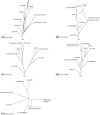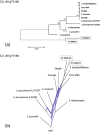Evidence of cryptic introgression in tomato (Solanum lycopersicum L.) based on wild tomato species alleles
- PMID: 22871151
- PMCID: PMC3462117
- DOI: 10.1186/1471-2229-12-133
Evidence of cryptic introgression in tomato (Solanum lycopersicum L.) based on wild tomato species alleles
Abstract
Background: Many highly beneficial traits (e.g. disease or abiotic stress resistance) have been transferred into crops through crosses with their wild relatives. The 13 recognized species of tomato (Solanum section Lycopersicon) are closely related to each other and wild species genes have been extensively used for improvement of the crop, Solanum lycopersicum L. In addition, the lack of geographical barriers has permitted natural hybridization between S. lycopersicum and its closest wild relative Solanum pimpinellifolium in Ecuador, Peru and northern Chile. In order to better understand patterns of S. lycopersicum diversity, we sequenced 47 markers ranging in length from 130 to 1200 bp (total of 24 kb) in genotypes of S. lycopersicum and wild tomato species S. pimpinellifolium, Solanum arcanum, Solanum peruvianum, Solanum pennellii and Solanum habrochaites. Between six and twelve genotypes were comparatively analyzed per marker. Several of the markers had previously been hypothesized as carrying wild species alleles within S. lycopersicum, i.e., cryptic introgressions.
Results: Each marker was mapped with high confidence (e<1 x 10-30) to a single genomic location using BLASTN against tomato whole genome shotgun chromosomes (SL2.40) database. Neighbor-joining trees showed high mean bootstrap support (86.8 ± 2.34%) for distinguishing red-fruited from green-fruited taxa for 38 of the markers. Hybridization and parsimony splits networks, genomic map positions of markers relative to documented introgressions, and historical origins of accessions were used to interpret evolutionary patterns at nine markers with putatively introgressed alleles.
Conclusion: Of the 47 genetic markers surveyed in this study, four were involved in linkage drag on chromosome 9 during introgression breeding, while alleles at five markers apparently originated from natural hybridization with S. pimpinellifolium and were associated with primitive genotypes of S. lycopersicum. The positive identification of introgressed genes within crop species such as S. lycopersicum will help inform conservation and utilization of crop germplasm diversity, for example, facilitating the purging of undesirable linkage drag or the exploitation of novel, favorable alleles.
Figures



Similar articles
-
A new genetic linkage map of tomato based on a Solanum lycopersicum x S. pimpinellifolium RIL population displaying locations of candidate pathogen response genes.Genome. 2009 Nov;52(11):935-56. doi: 10.1139/g09-065. Genome. 2009. PMID: 19935918
-
Bin mapping of tomato diversity array (DArT) markers to genomic regions of Solanum lycopersicum × Solanum pennellii introgression lines.Theor Appl Genet. 2012 Mar;124(5):947-56. doi: 10.1007/s00122-011-1759-5. Epub 2011 Dec 13. Theor Appl Genet. 2012. PMID: 22159755 Free PMC article.
-
Exploring genetic variation in the tomato (Solanum section Lycopersicon) clade by whole-genome sequencing.Plant J. 2014 Oct;80(1):136-48. doi: 10.1111/tpj.12616. Epub 2014 Sep 3. Plant J. 2014. PMID: 25039268
-
Trait discovery and editing in tomato.Plant J. 2019 Jan;97(1):73-90. doi: 10.1111/tpj.14152. Epub 2018 Dec 24. Plant J. 2019. PMID: 30417464 Review.
-
Current Status of Early Blight Resistance in Tomato: An Update.Int J Mol Sci. 2017 Sep 21;18(10):2019. doi: 10.3390/ijms18102019. Int J Mol Sci. 2017. PMID: 28934121 Free PMC article. Review.
Cited by
-
Mediterranean Long Shelf-Life Landraces: An Untapped Genetic Resource for Tomato Improvement.Front Plant Sci. 2020 Jan 10;10:1651. doi: 10.3389/fpls.2019.01651. eCollection 2019. Front Plant Sci. 2020. PMID: 31998340 Free PMC article.
-
Analysis of wild-species introgressions in tomato inbreds uncovers ancestral origins.BMC Plant Biol. 2014 Oct 28;14:287. doi: 10.1186/s12870-014-0287-2. BMC Plant Biol. 2014. PMID: 25348801 Free PMC article.
-
Extent of wild-to-crop interspecific introgression in grapevine (Vitis vinifera) as a consequence of resistance breeding and implications for the crop species definition.Hortic Res. 2022 Jan 18;9:uhab010. doi: 10.1093/hr/uhab010. Online ahead of print. Hortic Res. 2022. PMID: 35039824 Free PMC article.
-
Multiple QTL for horticultural traits and quantitative resistance to Phytophthora infestans linked on Solanum habrochaites chromosome 11.G3 (Bethesda). 2014 Dec 12;5(2):219-33. doi: 10.1534/g3.114.014654. G3 (Bethesda). 2014. PMID: 25504736 Free PMC article.
-
Linkage relationships among multiple QTL for horticultural traits and late blight (P. infestans) resistance on chromosome 5 introgressed from wild tomato Solanum habrochaites.G3 (Bethesda). 2013 Dec 9;3(12):2131-46. doi: 10.1534/g3.113.007195. G3 (Bethesda). 2013. PMID: 24122052 Free PMC article.
References
-
- Tosi AJ, Detwiler KM, Clifford SL. X-chromosomal synapomorphies provide a non-invasive test for introgression among Cercopithecus monkeys. Conserv Genet. 2006;7(5):803–805. doi: 10.1007/s10592-005-9072-y. - DOI
-
- Hajjar R, Hodgkin T. The use of wild relatives in crop improvement: a survey of developments over the last 20 years. Euphytica. 2007;156(1):1–13. doi: 10.1007/s10681-007-9363-0. - DOI
-
- Dearing C. Muscadine grape breeding. J Hered. 1917;8(9):409–424.
Publication types
MeSH terms
Substances
LinkOut - more resources
Full Text Sources
Other Literature Sources

